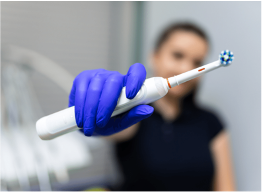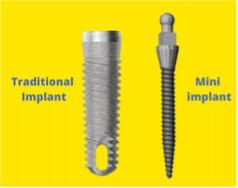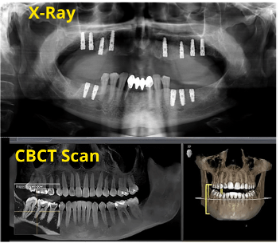

By Leanne.
Share article:
Myth: Everyone will know you have dental implants.
The good thing about full arch dental implants is how much they can look like natural teeth. Especially when you have worked with skilled Dental Practitioners and Dental Technicians, unless you tell people you have dental implants, they probably won’t even notice. You can have and should strive for a natural shade to enhance your smile, not make it look false.

Myth: You can’t get your final teeth in a day.
Immediate loading of your final bridge(s) is now possible thanks to technological advances and the All at Once® patent-pending technique. Your teeth can be extracted and implants placed on the same day.
Your final All at Once® implant bridge will be designed and made prior to your extractions and implant placement. Your new implant bridge is then attached to the implants by the dentist, who also makes any necessary last-minute adjustments to your bite and fit.

Myth: Dental implant surgery is always invasive and distressing.
While placing dental implants requires invasive surgery; the use of oral sedation, numbing gels/injections, surgical techniques and technology all work together to maximise your comfort and healing. Implant placement is usually a day procedure that’s completed under local or IV anaesthetics to help promote relaxation and comfort.
Regular over-the-counter analgesia, prescribed pain medication, and topical ice packs are often all that’s needed in the first few days. Many people return to work and normal activities within a few days to a week following full arch replacement.
Anxiety can be minimised by using techniques such as listening to your own music/headphones during the procedure, talking to other patients who have undergone the procedure and having a support person close by.

Myth: Dental implants can cause long-term headaches.
A recent myth is that titanium dental implants cause headaches or migraines. However, there is no clinical research to support this claim. In fact, titanium is very well tolerated in the body for many prosthetic procedures, including hip and knee replacements.
If you experience severe headaches after receiving dental implants, there may have been a complication during surgery. Although rare, dental implants can damage nerves or be incorrectly placed in the sinus cavity.
A misaligned bite also referred to as TMJ, could also cause headaches after a dental implant procedure. An X-ray or CT can likely identify and resolve the cause of your headaches if it is related to your implants. Always discuss this with your dental practitioner if you are experiencing symptoms of concern.

Myth: You must be in perfect health to get dental implants.
While ideally, we should be in good general health, this doesn’t mean that people who have diabetes, heart disease and other illness can’t get dental implants. The goal during treatment is to make sure that everything heals quickly with as few side effects and discomfort as possible.
However, uncontrolled health conditions can sometimes impede healing, making your treatment last longer than usual. Therefore, if you have been diagnosed with a chronic health problem, the goal is to have it under control before you commence your treatment. Your dental practitioner and your doctor can work together to implement a plan of care.

Myth: You have to stay on a soft diet forever following dental implant surgery.
There is an initial period where you need to have a diet of super-soft foods. This is generally restricted to the first week after the implants are placed; then, you can adjust to soft chew foods and progress onto easy eating. This period of time is during the integration phase of the healing process and lasts up to 3-4 months. After this, you’ll be able to return to eating all of the foods you love. In fact, many patients who had missing teeth or wore dentures are ecstatic to find they can once again properly chew and eat foods they weren’t able to previously.

Myth: I don’t have to go to the dentist ever again.
Wrong! You must continue to see your specialist or general dentist, who is skilled in the care of dental implant bridges. Just like the general population, you should have a hygiene appointment twice a year for cleanings, checkups, and inspection of plaque buildup that could lead to Peri-Implantitis, the primary cause of implant failure.

Myth: Mini implants are just as good.
You may have heard of Mini Dental Implants. These toothpick-sized implants are narrower than most commonly used dental implants. They are placed through less-invasive techniques and are mainly used to stabilise a lower denture.
Mini implants are mostly marketed to patients that have no lower teeth. Although they may be slightly less expensive in the short term, there are potential long-term concerns associated with their usage.
Their reduced diameter can result in decreased strength and an increased risk of failure. They are often used for snap-in dentures and can be immediately loaded. A mini dental implant is defined as having a diameter smaller than 3.0 mm.

Myth: Everyone requires bulky temporary bridges.
Only those unfortunate enough to not go to an All at Once® provider.

Myth: Bridges won’t stain.
Now this depends on what your bridges are made of. PMMA (Acrylic) can stain, and 3D-printed teeth can stain. Zirconia/Porcelain and the newer nano-ceramic materials should not stain. Your bridges can be removed periodically for a deep clean.
One downside is you cannot soak them in a denture bleach cleaner as you would dentures, as very few denture cleaners are safe for use in the mouth.
As long as you care for your teeth properly at home and see your team for professional cleanings every six months, your dental implant bridges should remain white and bright.

Myth: I only need an X-ray and not a CBCT scan.
Dental X-rays are really only 2D photographs of the teeth, bones, soft tissues and gums. However, a dental CBCT (Cone Beam Computed Tomography) scan creates a detailed 3D image of dental structures, soft tissues, nerve pathways and bone in just one scan by taking a 360-degree image of the area.
The CT scan is essential to examine the quality and quantity of your jaw bone. It is also vital for the implants’ accurate, precise, and safe placement with as few complications as possible.


Disclaimer: The information provided on this platform, including text, graphics, and images, is intended for general informational purposes only. It is not a substitute for professional dental advice, diagnosis, or treatment. For specific dental concerns, it is crucial to consult with a qualified dental practitioner. They will be able to assess your individual circumstances, provide accurate diagnoses, and offer appropriate treatment options tailored to your specific needs
Print article:
Share article:
Subscribe To Leanne's Blog
Ready for your new smile?


